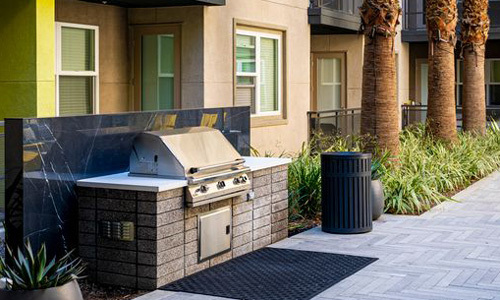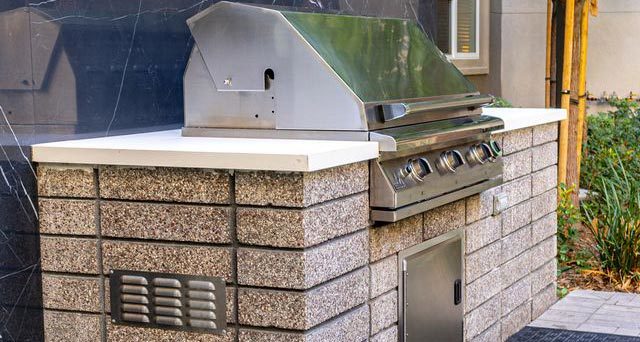Customizing Your Grill Island: Essential Tips for Multifamily Properties
Customizing Your Grill Island: Essential Tips for Multifamily Properties
11 minute read | Grills

Outdoor living spaces are becoming a must-have feature in multifamily housing like apartments and condos. These areas not only make properties more attractive but also offer a place for residents to gather, cook, and connect. Among the many outdoor features, custom grill islands stand out as a key element that can transform an ordinary patio into a social hub. Whether built from scratch or prefabricated, these islands can be the centerpiece of an outdoor kitchen, combining style with practicality.
This guide will walk you through the essentials of customizing a grill island for multifamily use. We’ll look at both custom-built and prefabricated options, discuss the importance of proper ventilation, and help you choose the right grill type for your property. By the end, contractors, developers, and property owners will have all the tools needed to create a safe, functional, and stylish outdoor cooking area.
The Benefits of Custom Outdoor Grill Islands
Design Flexibility
One of the biggest advantages of a custom-built grill island is the freedom to design it exactly to your needs. Unlike standard models, custom islands can be tailored to fit any space, whether it’s small, irregularly shaped, or part of a larger outdoor layout. This flexibility allows for unique designs that match the property's architecture and surroundings.
You can choose from a variety of materials, including concrete, brick, stone, or even wood, each offering different looks and durability. For example, concrete provides strength and longevity, while wood adds a warm, natural feel. The choice of material can reflect the overall aesthetic of the property, ensuring the island blends in seamlessly.
Functionality
Beyond just looking good, custom grill islands are designed with real-world use in mind. They can include built-in storage, sinks, trash bins, and even extra cooking appliances. For instance, a well-designed island might have a sink with running water, drawers for utensils, and a space for a beverage cooler. This makes grilling more convenient and enjoyable for residents.
Some islands even come with double-burner stoves, which allow for more versatility in cooking—perfect for boiling water, stir-frying, or making soups. A dedicated beverage center is another popular addition, keeping drinks cold and within reach during barbecues.
Aesthetic Appeal
Custom grill islands can elevate the look of any outdoor space. They act as a focal point, drawing people in and creating a sense of community. Whether simple or elaborate, the design can reflect the personality of the property owner or the vibe of the neighborhood.
In multifamily settings, a thoughtfully designed grill island can enhance the overall appeal of the property. It encourages residents to spend time outdoors, socialize, and enjoy the amenities. This can make the property more attractive to potential renters and increase its value over time.
Durability
Custom grill islands are built to last, especially when paired with high-quality grills like those from PGS. These structures are made with materials that can withstand weather, heat, and frequent use. This durability is crucial in multifamily environments where the grill may be used by multiple residents daily.
A well-constructed island ensures long-term reliability, reducing maintenance costs and providing a great return on investment. It’s a smart choice for property owners who want to offer their tenants a premium outdoor experience.
Prefabricated Grill Islands: A Smart Alternative
Cost-Effective Solution
If budget is a concern, prefabricated grill islands are a great alternative. These units are manufactured off-site and delivered ready to assemble, cutting down on labor and construction time. This makes them a more affordable option without sacrificing quality or functionality.
For multifamily properties aiming to add a nice touch to their outdoor areas without overspending, prefabricated islands are an excellent choice. They offer the same look and usability as custom ones, but at a much lower cost.
Easy Installation
Another benefit of prefabricated islands is how quickly they can be installed. Unlike custom builds that take days or weeks, these units can often be assembled in just one day. This is especially useful for rooftop patios or other spaces where construction time is limited.
Plus, their lighter weight makes them suitable for rooftops or other areas where heavy structures aren’t feasible. This makes them ideal for urban or compact developments.
Versatility and Mobility
Prefabricated islands are compatible with various types of grills, allowing for flexible choices. They can mimic the look and feel of custom islands, giving a premium appearance at a fraction of the price.
While they may not offer the same level of customization, they still provide enough flexibility for most multifamily applications. Plus, some models can be moved if needed, making them a good option for properties that plan to update or reconfigure their outdoor spaces later.
Safety First: Ventilation and Compliance
Why Ventilation Matters

Proper ventilation is essential when building a custom grill island, especially for propane grills. Without it, heat and gas can build up, posing serious safety risks. This is why it's important to follow the manufacturer's guidelines and ensure there are enough vents to allow heat and gas to escape.
Good ventilation also helps protect the grill itself and surrounding structures from damage caused by excessive heat. This is particularly important for islands made with combustible materials like wood or certain plastics.
Complying with Safety Codes
When designing a grill island, it's vital to follow local and national safety regulations. These codes are in place to ensure the structure is safe for everyone using it. Ignoring them could lead to fines, legal issues, or even accidents.
Always check the grill manufacturer's manual for specific instructions on installation and ventilation. You should also consult with local authorities to ensure your design meets all required standards.
Selecting the Right Grill Type for Your Property
Whether you're building for a residential complex or a commercial development, choosing the right grill is key. We've been building patio grills for decades, and we know that each fuel type has its own benefits.
Propane Grills
Propane grills are a popular choice for multifamily properties due to their portability and powerful heat output. They run on propane tanks, which can be easily replaced or refilled. This makes them ideal for locations without access to natural gas lines.
However, because they produce a lot of heat, proper ventilation and heat shielding are necessary to prevent safety hazards. Make sure to store propane tanks in a cool, shaded area away from direct sunlight or heat sources.
Natural Gas Grills
Natural gas grills are a great option for properties with access to a gas line. They’re connected directly to the property’s gas supply, so there’s no need to replace tanks manually. This makes them more convenient and cost-effective in the long run.
But installing a natural gas grill requires professional help to ensure everything is set up safely and correctly. Always hire a licensed contractor for this task.
Electric Grills
Electric grills are becoming more popular, especially in cities focused on sustainability. They’re easy to maintain and don’t require gas lines or tanks. However, they typically don’t get as hot as gas grills, making them better suited for smaller spaces or indoor use.
Electric grills need a special NEMA 6-30 outlet, which may require an electrician to install. But for properties that prefer all-electric setups, they’re a solid choice.
How to Customize a Grill Island
Planning the Layout
The first step in customizing a grill island is planning. Property owners should start by assessing available space, resident needs, and budget. This phase sets the foundation for the entire project.
Work with architects and contractors to create a detailed blueprint that includes the size and shape of the island, the type of grill, and any accessories you want to include. Also consider the flow of the space to ensure it’s comfortable for cooking and socializing.
Choosing Materials and Accessories
Once the design is set, it’s time to pick materials and accessories. Choose durable, weather-resistant materials like concrete, stone, or brick to ensure the island lasts for years.
Popular accessories include sinks, storage cabinets, beverage centers, and additional cooking appliances like double-burner stoves. These additions make the island more functional and user-friendly for residents.
Installation and Safety
During installation, pay close attention to safety requirements, especially ventilation and heat shielding. For prefabricated islands, the process is faster, but it’s still important to ensure everything is properly secured and meets code.
Whether you go custom or prefabricated, safety should always come first. Proper setup ensures the grill island is both beautiful and safe for everyone to use.
Final Touches
After the island is installed, it’s time to add finishing touches like lighting, seating, or decorative elements. These details can transform the space into a welcoming and inviting area for residents.
Before putting the island into use, do a final inspection to make sure everything works as expected and that all safety measures are in place. This ensures the space is ready for communal use and delivers the best experience for everyone.
Whether you choose a custom-built island or a prefabricated one, the goal is to create a safe, functional, and stylish outdoor kitchen that residents will love. With the right design, materials, and attention to detail, you can turn any patio into a gathering spot that enhances the property’s value and appeal.
Want more information? Have a question? Contact us today, and we will be happy to help!
Transport Box,Tractor Transport Box,Transport Box For Tractor,3 Point Transport Box
Changzhou Kafurter Machinery Co., Ltd , https://www.kafurter.com